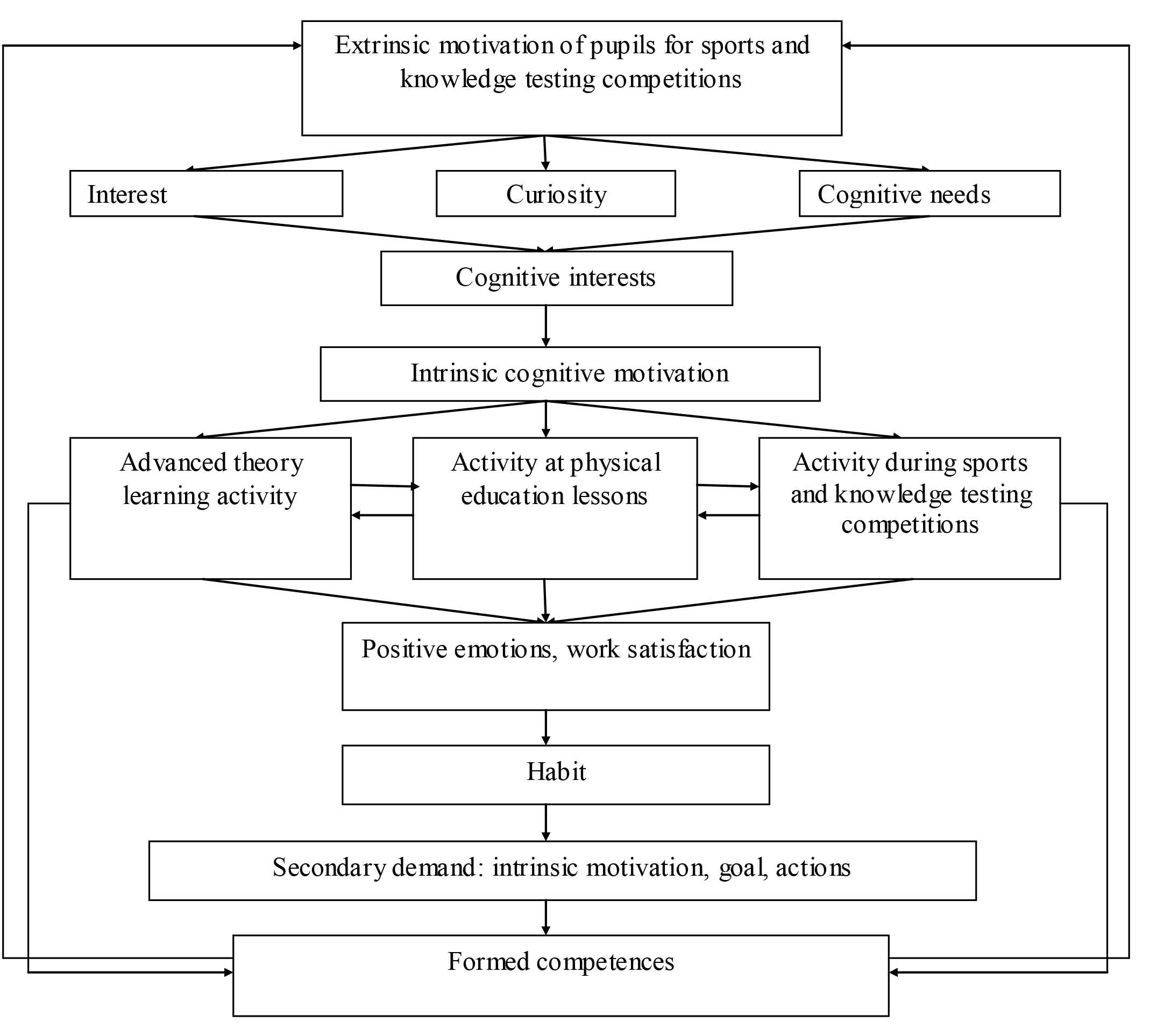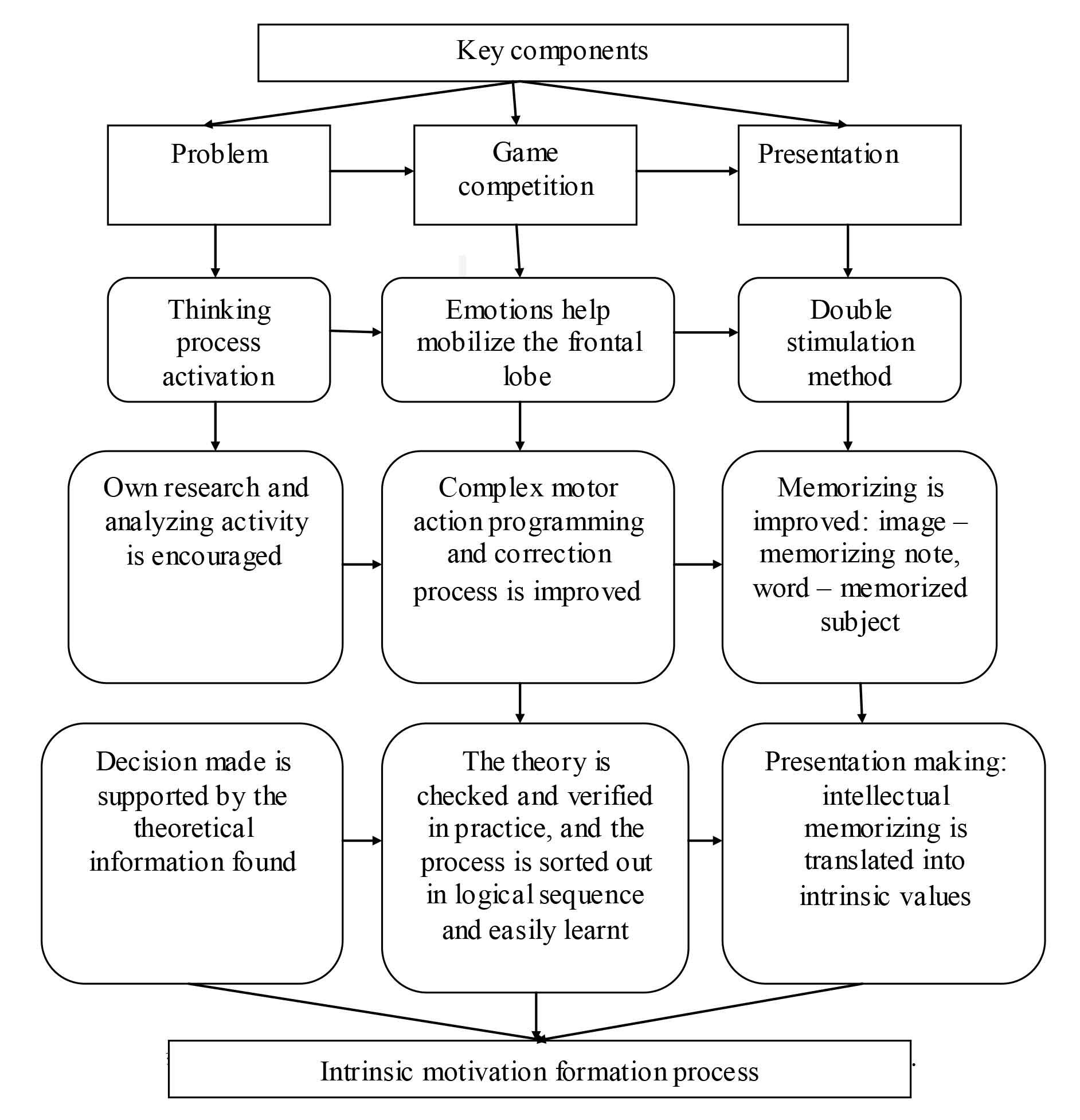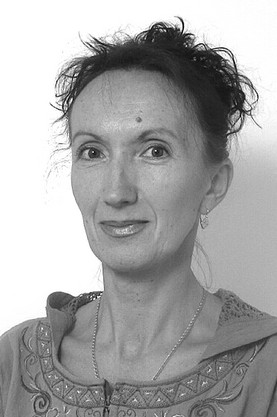Physical education of health-impaired schoolchildren based on competency-building approach: focus and efficiency
Фотографии:
ˑ:
Associate Professor, PhD L.A. Parfenova
G.B. Glazkova
Volga Region State Academy of Physical Culture, Sport and Tourism, Kazan
Keywords: health-impaired schoolchildren, health and fitness activities, intrinsic motivation, extrinsic motivation, competence, competency, competency-building approach.
Introduction
It is a matter of common knowledge that restricted motor activity is rated among the most serious factors of negative influence on the health standards of schoolchildren [3, 4].
Therefore, top priority in the modern education process is to be given to the initiatives to: increase the child’s body adaptation abilities to meet the education process challenges; develop and implement new axiological health agenda; and foster conscientious demand for systemic physical exercises – through key competencies being formed in the physical education domain of the school education process.
The above priorities are of special importance for education of schoolchildren diagnosed with different health (nosological) impairments for the reason that children of this category face certain problems in the curriculum assimilation process due to their health limitations.
Therefore, the education system objectively needs to offer the relevant motivation system and form a facilitating psychological and educational environment to help shape up interest in physical education and demand for systemic physical training in the middle-age schoolchildren [3, 4].
In opinions of the prominent national psychologists (P.Y. Gal’perin, D.B. El’konin, N.F. Talyzin), motivations may be classified into the intrinsic and extrinsic ones [7]. We assumed that the process to form the intrinsic motivation for regular motor activity will provide a foundation for physical education and health competency formation efforts additionally supported by the encouraging extrinsic motivation system prudently created by the physical education teacher using the relevant physical education and competitive tools of special effect and potential in the learning activity and interest awaking process.
Methodology and structure of the study
Let us visualize the competence formation mechanism in application to school sports activities through the following hierarchical model structure (see Figure 1) that spells out the relevant psychological and pedagogical aspects of the process.

Figure 1. Competency formation model in application to physical education
In the educational curriculum design process, we gave the top priority to the problem-solving education methodology selected from a wide variety of popular modern education methods. With this goal in mind, we developed a new interactive Problem-solving Intellectual Sports and Health (PISH) Game.
The Problem-solving Intellectual Sports and Health (PISH) Game is an interactive form of pupils' learning activity designed to help them: define a problem; find the required information, analyze it and find the problem solutions; and implement the solution(s) in practice; the process being supported by multimedia presentation tools as an obligatory condition.
Given hereunder on Figure 2 is the model algorithm of the secondary demand for motor activity using the PISH Game toolkit.

Figure 2. Secondary demand for motor activity using the PISH Game toolkit.
A key component of the PISH Game is the problematic situation that encourages pupils to intensify their thinking process; take the independent information-mining initiative; find a solution to the problem; and implement the solution in practice.
Every PISH Game is designed to offer a sequence of interrelated problem-solving games with the final decision coming up at the final stage of the PISH Game.
This staged and prolonged game design is based on the proven psychological methodology by B.V. Zeygarnik who considers an unfinished action effect as the key motivation factor that forces the subject individual to think over the process once and again until he/she finds a solution for the unfinished process, and these efforts are believed to be imperative for the self-acquired knowledge being firm and highly applicable in practical motor activity of the subject.
Every game session is supported by a presentation that is designed to give the direct memorizing tools to learn and memorize the theoretical provisions – based on the double-stimulation method by L.S. Vygotskiy and the intrinsically mediated memorization method by A.N. Leontiev [1].
The study was designed to test the effectiveness of the authors’ innovative approach to the key physical education competences formation process in application to schoolchildren.
Subject to the educational experiment were two groups of 45 pupils each – Study Group (SG) and Reference Group (RG). The physical education process design for the SG and RG is given hereunder in Table 1.
Table 1. Physical education process design for SG and RG
|
|
Monday |
Tuesday |
Wednesday |
Thursday |
Friday |
|
RG |
PE lesson |
SHG |
PE lesson |
SHG |
PE lesson |
|
SG |
PE lesson, ICT-based homework |
Lesson under modular system |
PE lesson, meta-subject theoretical session |
Lesson under modular system |
PE lesson, ICT-based homework |
Note: PE - physical education; SHG - special health group; ICT - information/ communication technologies
Study results and discussion
The proposed method was subject to experimental tests that verified it being highly effective based on the variety of test indices characteristic of the physical education process showing notable improvement for the middle-age pupils diagnosed with different health impairments.
As seen from the SG versus RG group average physical fitness indices, the SG pupils showed notably better education results as verified by every test index (see Table 2 hereunder).
Table 2. Physical fitness indices variation statistics for Study Group versus Reference Group pupils
|
|
5th grade girls |
6th grade girls |
5th grade boys |
6th grade boys |
||||
|
RG growth rate |
SG growth rate |
RG growth rate |
SG growth rate |
RG growth rate |
SG growth rate |
RG growth rate |
SG growth rate |
|
|
30 m sprint, s |
-0,11 |
-0,41 |
0,02 |
-0,50 |
-0,10 |
-0,38 |
0,00 |
-0,30 |
|
Marked ball chase test, s |
-0,05 |
-0,86 |
0,00 |
-0,90 |
-0,13 |
-0,79 |
-0,21 |
-1,04 |
|
6-minute run test, m |
5,50 |
102,50 |
3,00 |
102,00 |
-18,50 |
133,00 |
43,00 |
167,50 |
|
Standing jump test, cm |
2,50 |
9,10 |
2,00
|
8,30 |
2,00 |
16,60 |
2,00 |
9,70 |
|
Straight leg stretch exercise, cm |
2,10 |
8,20 |
1,40 |
7,10 |
1,20 |
6,90 |
-0,50 |
6,20 |
|
Push-up test, reps |
0,40 |
4,00 |
0,20 |
3,40 |
0,90 |
4,80 |
0,50 |
5,10 |
|
Ruler drop test, cm |
-1,20 |
-8,00 |
-0,70 |
-7,70 |
-1,80 |
-7,00 |
-0,30 |
-7,00 |
Test data of the SG pupils showed the considerable growth of the overall conditioning levels, and this fact demonstrates the competency-building physical education process being highly effective.
To explore the impacts of the innovative learning method, we tested the values-and-concept-centred competences formation process in the SG and RG pupils. Based on the past research findings, we developed a set of criteria and rating tools to assess the competence formation progress, with every competence level being scored by the relevant criteria [2, 3, 5, 6]. The competency formation process is classified into four levels, with each level being scored using the 5-point system (2 points for low level; 3 points for average level; 4 points for good level; and 5 points for excellent level).
In the course of the experiment, progress of the tested pupils in the axiological competences formation process was scored for every process component (with the relevant rating criteria), including the scores for cognitive-and-motor activity in the PISH Game (see Table 3) sessions.
Table 3. Scores for individual contributions in the PISH Game
|
Process components/ criteria |
|
Competence level |
||||||||
|
|
Low |
Average |
Good |
Excellent |
||||||
|
count |
% |
count |
% |
count |
% |
count |
% |
|||
|
Personal active efforts to find solutions for problems |
S |
SG |
_24_ 23 |
53,2 51,1 |
_14_ 14 |
31,1 31,1 |
_4_ 4 |
8,9 8,9 |
_3_ 4 |
6,8 8,9 |
|
RG |
||||||||||
|
E |
SG |
_0_ 22 |
_0_ 48,9 |
_0_ 13 |
_0_ 28,9 |
_3_ 6 |
6,8_ 13,3 |
_42_ 4 |
93,2 8,9 |
|
|
RG |
||||||||||
|
Substantiation of the problem solution found |
S |
SG |
_27_ 26 |
60,0 57,7 |
_13_ 14 |
28,9 31,1 |
_4_ 3 |
_8,9 6,8 |
_1_ 2 |
_2,2 4,4 |
|
RG |
||||||||||
|
E |
SG |
_0_ 26 |
_0_ 57,7 |
_0_ 14 |
_0_ 31,1 |
_4_ 3 |
8,9 6,8 |
_41_ 2 |
91,1 4,4 |
|
|
RG |
||||||||||
|
Presentation of the problem solution in a multimedia format |
S |
SG |
_18_ 18 |
40,0 40,0 |
_12_ 15 |
26,6 33,3 |
_12_ 9 |
26,6 19,9 |
_3_ 3 |
_6,8 6,8 |
|
RG |
||||||||||
|
E |
SG |
_0_ 17 |
_ 0_ 37,7 |
_0_ 17 |
_0_ 37,7 |
_3_ 8 |
6,8_ 17,8 |
_42_ 3 |
93,2 6,8 |
|
|
RG |
||||||||||
|
Ability to convey physical exercises and apply in practice the knowledge acquired |
S |
SG |
_23_ 28 |
51,1 62,2 |
_14_ 12 |
31,1 26,6 |
_4_ 3 |
8,9 6,8 |
_4_ 2 |
8,9 4,4 |
|
RG |
||||||||||
|
E |
SG |
_0_ 27 |
_ 0_ 60,0 |
_0_ 13 |
_0_ 28,9 |
_3_ 4 |
6,8_ 8,9 |
_42_ 1 |
93,2 2,2 |
|
|
RG |
||||||||||
|
Contribution to the final presentation and the ability to make conclusions |
S |
SG |
_29_ 30 |
64,4 66,7 |
_11_ 8 |
24,4 17,8 |
_3_ 5 |
6,8_ 11,1 |
_2_ 2 |
4,4_ 4,4 |
|
RG |
||||||||||
|
E |
SG |
_0_ 28 |
_0_ 62,2 |
_0_ 9 |
_0_ 19,9 |
_3_ 5 |
_6,8 11,1 |
_42 3 |
93,2 6,8 |
|
|
RG |
||||||||||
Note: count - number of students; S - start of experiment; and E - end of experiment
Excellent score means that the schoolchild clearly understands the problematic situation, can come up with his/her own hypothesis; contribute to the team efforts; discuss the study planning issues; design the information mining activity; make prior processing of the data mined; present the study results on his/her own or on behalf of the team; make a presentation; actively oppose to arguments and respond (5 points);
Good score means that the pupil is capable of applying the knowledge in the proposed problem solving process, albeit his/ her theoretical knowledge appears to be loosely connected to the practical application ability; and/or the student finds it difficult to communicate the problem solutions found in the process (4 points);
Average score means that the pupils is capable of understanding the problem and setting goals for the study, albeit the problem solution he/ she offers is incomplete for the reason that his/her meta-subject notions are insufficient or lacking (3 points);
Low score means that the pupil fails to prove relevance of the problem; describe the key elements of the potential problem solutions; and/or failed to solve the proposed problem (2 points).
Conclusion
The physical education process design based on the competency-building approach will help optimize physical education of schoolchildren diagnosed with different health impairments through the focused efforts to form cognitive interest, foster sustained motivation for systemic physical exercises and develop a secondary demand for healthy lifestyle in the schoolchildren.
References
- Vygotskiy L.S. Sobranie sochineniy: v 6 t. (Collected Works: 6 Vol.) / L.S. Vygotskiy. – Moscow, 1983. – V. 3. History of development of higher mental functions. – 144 p.
- Glazkova G.B. Primenenie informatsionno-kommunikatsionnykh tekhnologiy v fizkul'turno-obrazovatel'nom protsesse shkol'nikov, imeyushchikh otkloneniya v sostoyanii zdorov'ya (Information and communication technologies in sports educational process of pupils with health disorders) / G.B. Glazkova, L.A. Parfenova // Nauchnoe mnenie. – 2014. – № 9(2). – P. 151–158
- Durkin P.K. Formirovanie u shkol'nikov interesa k fizicheskoy kul'ture: ucheb. posobie dlya fakul'tetov fizicheskoy kul'tury (Formation of pupils' interest in physical education: study guide for faculties of Physical Culture) / P.K. Durkin. – Arkhangelsk: Litera, 1996. – 120 p.
- Eremeeva V.D. Mal'chiki i devochki – dva raznykh mira (Boys and girls - two different worlds) / V.D. Eremeeva, T.P. Khrizman / Neyropsikhologi – uchitelyam, vospitatelyam, roditelyam, shkol'nym psikhologam (Neuropsychologist's recommendations for teachers, educators, parents, school psychologists). – Moscow: LINKA - PRESS, 1998. – 184 p.
- Parfenova L.A. Integrativny podkhod v fizicheskom vospitanii shkol'nikov, imeyushchikh otkloneniya v sostoyanii zdorov'ya: monografiya (Integrative approach to physical training of pupils with health disorders: monograph)/ L.A. Parfenova. – Ulyanovsk: UlGPU (UlSPU), 2013. – 160 p.
- Parfenova L.A. Organizatsionno-soderzhatel'nye aspekty fizicheskogo vospitaniya uchashchikhsya srednego shkol'nogo vozrasta, imeyushchikh otkloneniya v sostoyanii zdorov'ya (Organizational and substantive aspects of physical education of secondary pupils with medical issues) / L.A. Parfenova, G.B. Glazkova, S.N. Klyuchnikova // Pedagogiko-psikhologicheskie i mediko-biologicheskie problemy fizicheskoy kul'tury i sporta. – 2012. – P. 25. – № 4. – P. 116–124.
- Federal'ny gosudarstvenny standart srednego (polnogo) obshchego obrazovaniya (Federal State standard of secondary (complete) general education). – Moscow: Omega, 2012. – 17 p.
- Khutorskoy A.V. Klyuchevye kompetentsii kak komponent lichnostno-orientirovannoy paradigmy obrazovaniya (Key competences as part of personality-centered paradigm of education) / A.V. Khutorskoy / Doklady 4-y Vseros. distantsionnoy avgustovskoy pedagogicheskoy konferentsii «Obnovlenie rossiyskoy shkoly» (Reports of the 4 th All-Russia distance August pedagogical conference "Russian school modernization" (August, 26 - 10 September 2002). – http:// www.eidos.ru/conf/
- El'konin D.B. Psikhologiya igry (The Psychology of Play) / D.B. El'konin. – Moscow: Pedagogika, 1978. – 304 p.



 Журнал "THEORY AND PRACTICE
Журнал "THEORY AND PRACTICE